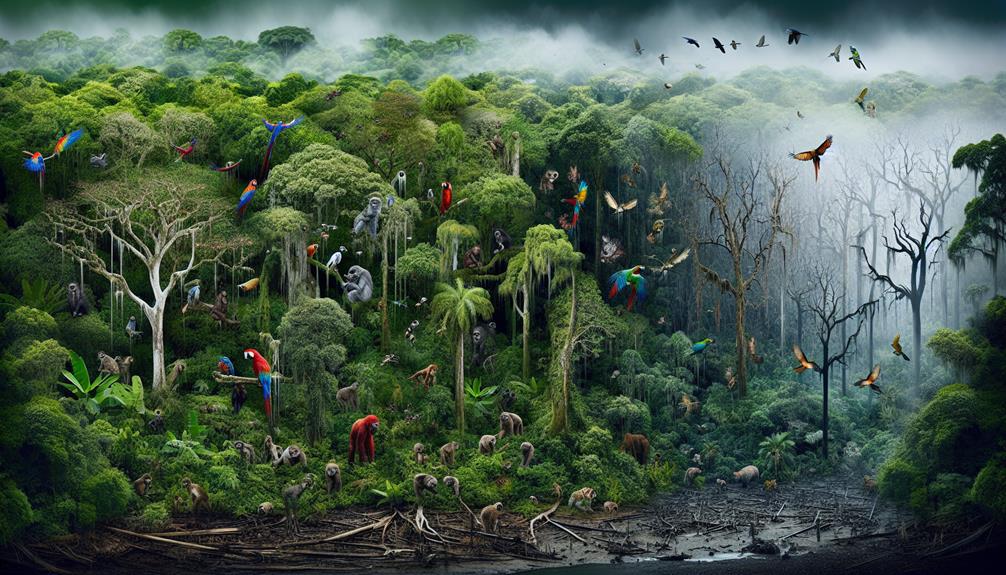You might think you’ve heard it all when it comes to biodiversity loss, but the complexity and urgency of this issue demand your closer attention. As you navigate your daily life, the choices you make have ripple effects on ecosystems worldwide, from the coffee you drink to the paper you use. Understanding the interconnected causes—from climate change to deforestation—is essential in shaping effective solutions. If you’re wondering how your actions can genuinely make a difference in conserving the planet’s biodiversity, consider what’s at stake not just for countless species but for human communities as well. What role can you play in turning the tide?
Biodiversity Loss
Biodiversity loss is a critical global issue driven by numerous interrelated factors. Among the primary causes are habitat destruction, pollution, and the introduction of invasive species. Each of these threats contributes significantly to declining wildlife populations and the destabilization of ecosystems.
Furthermore, the impacts of climate change are compounding these threats, leading to heightened risks for biodiversity. A recent report from the Intergovernmental Science-Policy Platform on Biodiversity and Ecosystem Services (IPBES) indicates that approximately 1 million species face extinction, many within decades, primarily due to human activities.
The repercussions of biodiversity loss extend beyond ecological concerns; they have profound implications for food security and human livelihoods. Disruption of food-producing systems threatens both the availability and nutritional quality of food globally.
Causes of Biodiversity Loss
The leading cause of biodiversity loss is human activities, which have far-reaching consequences for various species and ecosystems worldwide. Urbanization, industrial practices, and intensive agriculture are significant contributors to habitat destruction, displacing countless species and leading to dramatic declines in biodiversity.
In a study by the World Wildlife Fund (WWF), it was found that wildlife populations have plummeted by an average of 68% since 1970, predominantly due to human-induced habitat changes. Additionally, pollution from plastics, chemicals, and agricultural runoff further stresses ecosystems, affecting the health of species and their habitats.
Human Activities Impacting Biodiversity
Several human actions significantly contribute to biodiversity loss:
- Deforestation: This practice diminishes habitats, leading to increased extinction risks for many species. For example, the Amazon rainforest, often referred to as the “lungs of the planet,” has experienced alarming deforestation rates, with approximately 17% of its area lost in the last 50 years.
- Pollution: Contaminants from industrial activities and agriculture infiltrate ecosystems, harming both wildlife and plants. Microplastics, for instance, have been found in remote areas, affecting even the most isolated marine species.
- Climate Change: Alterations in climate patterns disrupt the habitats of numerous species, making them uninhabitable. The International Union for Conservation of Nature (IUCN) reports that climate change is a direct threat to nearly 50% of all species at risk of extinction.
- Overexploitation: Unsustainable fishing, hunting, and harvesting practices deplete resources faster than natural replenishment can occur, endangering entire ecosystems. The depletion of fish stocks in the oceans, for example, has led to significant declines in marine biodiversity.
Climate Change Effects on Biodiversity
Climate change has far-reaching consequences for biodiversity by modifying habitats, disrupting species interactions, and altering ecosystem dynamics. Rising temperatures and erratic weather patterns have become commonplace, with ecosystems struggling to adapt.
Marine environments are particularly vulnerable, facing challenges such as ocean acidification and elevated sea temperatures, which lead to coral bleaching. According to the National Oceanic and Atmospheric Administration (NOAA), nearly 50% of coral reefs have died in the last 30 years due to these stressors.
On land, species are migrating to higher altitudes or latitudes in search of suitable habitats, disrupting existing ecological networks. For instance, studies show that bird species are shifting northward at an average rate of 6.1 kilometers per decade. These shifts create mismatches in timing between species that rely on one another for survival, such as predators and their prey.
Moreover, climate change exacerbates the frequency and intensity of natural disasters like wildfires and hurricanes, leading to further habitat degradation. The cumulative effects of these events increase extinction risks for species that cannot adapt or relocate quickly enough.
Consequences of Biodiversity Loss
Understanding the consequences of biodiversity loss is critical, as it leads to ecosystem instability and potential collapse. A decline in species diversity weakens ecosystem resilience, rendering systems less capable of recovering from environmental stresses, thereby jeopardizing the services they provide.
These services are vital to human survival, including water purification, air quality, and climate regulation. A study by the World Resources Institute highlights that ecosystems with higher biodiversity provide greater stability and productivity, essential for sustaining human life.
Ecosystem Instability and Collapse
The loss of biodiversity can precipitate ecosystem instability, and in severe cases, lead to collapse, disrupting essential services:
- Pollination Decline: The reduction of bee populations has been linked to decreased crop yields, critically affecting food production.
- Water Purification: Diverse wetlands are more effective at filtering pollutants, thus maintaining water quality.
- Carbon Storage: Varied forest ecosystems sequester more carbon, helping mitigate climate change impacts.
- Soil Fertility: Biodiverse systems enhance soil quality, contributing to agricultural productivity.
Threats to Food Security
The decline in biodiversity poses significant threats to food security by undermining the resilience and variety of food sources. As crucial species that support crop growth diminish, the stability of food systems is at risk. For example, a decline in pollinators like bees has been shown to adversely impact the production of key crops such as almonds and blueberries, directly affecting both yield and quality.
Moreover, the genetic diversity within agricultural crops is decreasing, as intensive farming practices favor high-yielding, uniform varieties. This loss makes food systems increasingly vulnerable to diseases and climate change. A case study of the Irish Potato Famine illustrates the dangers of monoculture, where reliance on a single variety led to catastrophic crop failures due to disease.
To safeguard food security, it is imperative to support sustainable agricultural practices that prioritize biodiversity. This includes preserving natural habitats, employing agroecological methods, and enhancing the genetic diversity of crops. By protecting biodiversity, we secure our future food supply and promote ecological balance.
Mitigating Biodiversity Loss
To effectively tackle biodiversity loss, you must consider various conservation strategies that focus on protecting existing ecosystems and species.
Habitat restoration programs are pivotal as they aim to repair ecosystems that have been degraded or destroyed, thereby reinstating their ecological functions and species diversity.
Engaging local communities in biodiversity conservation not only raises awareness but also empowers them to take part in sustainable practices, ensuring long-term success in these initiatives.
Conservation Strategies
As you explore the importance of conservation strategies, it’s vital to comprehend the role of protected areas and reserves in mitigating biodiversity loss.
These zones are scientifically designated to safeguard ecosystems and species by regulating human activities and preventing habitat destruction.
Evaluating their impact involves analyzing coverage area, management practices, and biodiversity outcomes to make sure they’re not just paper parks but effective tools in conserving biodiversity.
Protected Areas and Reserves
Establishing protected areas and reserves is an essential strategy in combating biodiversity loss by legally safeguarding habitats from further degradation. Here’s why you should care:
- *Diverse ecosystems*: Reserves maintain ecological balance.
- *Species preservation*: Essential for endangered species.
- *Climate resilience*: Natural areas help buffer climate impacts.
- *Economic benefits*: They support eco-tourism and sustainable practices.
Understanding the role of protected areas can empower you to advocate effectively.
Habitat Restoration Programs
Habitat restoration programs directly address biodiversity loss by rejuvenating degraded ecosystems to support a diverse array of species. They focus on reviving natural habitats that have been diminished or altered by human activities, such as agriculture, urban development, or pollution. These programs employ a variety of techniques, including the reforestation of cleared lands, wetland restoration, and the reintroduction of native plant and animal species.
By re-establishing native vegetation, you’re not only providing food and shelter for wildlife but also improving soil quality and water regulation, which benefits agricultural productivity and reduces the impact of natural disasters. Additionally, restoring wetlands is important as they’re highly productive environments that filter pollutants, store carbon, and buffer against flooding.
The effectiveness of these programs often hinges on selecting appropriate native species and implementing sustainable management practices that prevent future degradation. Monitoring and adaptive management are essential to assess whether restoration efforts are meeting their biodiversity targets and to make necessary adjustments.
Restoration doesn’t just bring back species; it rebuilds ecosystems. This approach can be more cost-effective than trying to protect what’s left of degraded habitats and offers a proactive solution to the biodiversity crisis you’re facing today.
Community Engagement in Biodiversity Conservation
Building on habitat restoration efforts, engaging local communities is essential to sustaining long-term biodiversity conservation initiatives. You’ve likely seen firsthand how community involvement can transform projects, ensuring they’re not only adopted but also embraced over the long haul.
When locals are involved from the beginning, conservation projects become more than just external mandates; they integrate into the social and economic fabric of the community.
Here’s why your participation is vital:
- Local Knowledge: Communities possess intimate knowledge of their local ecosystems, which can lead to more effective and culturally sensitive conservation strategies.
- Stewardship: When you’re directly involved, there’s a stronger sense of ownership and responsibility towards the natural resources.
- Sustainable Practices: You can champion sustainable practices that align with traditional ways of life, promoting biodiversity while supporting local economies.
- Monitoring and Enforcement: Local involvement aids in the continuous monitoring and helps enforce conservation rules, making it difficult for illegal activities to go unnoticed.
Global Efforts and Policies
You’ll find that global efforts to combat biodiversity loss are often anchored in international agreements, such as the Convention on Biological Diversity, which commits countries to preserve ecological systems.
National Biodiversity Action Plans (NBAPs) are strategic frameworks that numerous countries have developed to implement these international goals at a local level, tailored to specific ecological needs.
These plans not only aim to protect endangered species but also work towards restoring habitats and maintaining genetic diversity.
International Agreements on Biodiversity Conservation
You’ve likely heard about the Convention on Biological Diversity (CBD), a pivotal international treaty formed in 1992. It’s significant because it sets out commitments for maintaining the world’s ecological underpinnings as a measure against ongoing biodiversity loss.
This agreement binds countries to conserve biodiversity, use biological resources sustainably, and fairly share the benefits arising from their utilization.
Convention on Biological Diversity (CBD)
The Convention on Biological Diversity (CBD) is a pivotal international treaty that aims to safeguard biological diversity through thorough strategies and coordinated global actions.
- Conservation: Focuses on the preservation of species and habitats.
- Sustainable Use: Promotes environmentally sound practices.
- Fair Sharing: Guarantees benefits from genetic resources are shared.
- Implementation: Countries develop national strategies to fulfill commitments.
You’re part of the global community tackling biodiversity loss.
National Biodiversity Action Plans
As you explore National Biodiversity Action Plans, it’s important to understand how legislation and regulations serve as foundational tools for biodiversity protection. These legal frameworks are tailored by individual countries to address specific environmental challenges and priorities, thereby contributing greatly to global conservation efforts.
They not only enforce habitat protection but also mandate sustainable practices and biodiversity monitoring, ensuring a structured approach to mitigating biodiversity loss.
Legislation and Regulations to Protect Biodiversity
Governments worldwide have developed National Biodiversity Action Plans as essential tools to combat biodiversity loss through targeted legislation and strategic regulations.
- Scope: These plans detail specific, localized threats to ecosystems.
- Targets: They set measurable conservation targets.
- Monitoring: Includes mechanisms for tracking progress.
- Public Engagement: Encourages community involvement and awareness.
These measures are fundamental in preserving our planet’s biodiversity.



